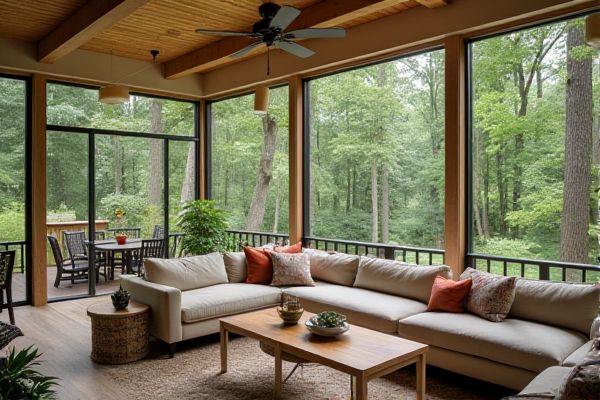
Glass wall sunrooms offer maximum natural light and unobstructed views while providing protection from weather and insects, creating a year-round comfortable space. Screened wall sunrooms enhance ventilation and outdoor ambiance but may offer less insulation and weather protection; discover which sunroom type best suits Your lifestyle by reading the full article.
Table of Comparison
| Feature | Glass Wall Sunroom | Screened Wall Sunroom |
|---|---|---|
| Material | Tempered glass panels | Mesh screen panels |
| Weather Protection | Full protection from rain, wind, and cold | Limited protection; breathable and ventilated |
| Insect Protection | Complete barrier against insects | Keeps insects out but less sealed |
| Insulation | High thermal insulation, energy efficient | Minimal insulation, more temperature fluctuations |
| Visibility | Clear, unobstructed views | Filtered view due to mesh |
| Cost | Higher initial investment | More affordable option |
| Maintenance | Requires regular cleaning of glass | Occasional screen repairs and cleaning |
| Usage Season | Year-round usability | Best suited for mild weather seasons |
Introduction to Sunroom Design Options
Glass wall sunrooms offer unobstructed views and maximum natural light, creating a bright and open space ideal for year-round enjoyment. Screened wall sunrooms provide enhanced ventilation and protection from insects, making them perfect for warm climates and casual outdoor living. Both designs can be customized with energy-efficient materials and roofing options to suit personal style and environmental needs.
Glass Wall Sunrooms: Key Features
Glass wall sunrooms feature floor-to-ceiling transparent panels that maximize natural light while offering unobstructed outdoor views. These structures are typically made with high-quality tempered or laminated glass, ensuring durability and enhanced insulation against weather elements. Your experience benefits from a sleek, modern aesthetic combined with energy efficiency and year-round usability.
Screened Wall Sunrooms: Key Features
Screened wall sunrooms provide excellent ventilation and protection from insects, allowing you to enjoy fresh air without pests. These structures typically feature durable aluminum frames and mesh screens designed to withstand various weather conditions while maintaining visibility. Their open design makes screened wall sunrooms ideal for those seeking a natural outdoor experience with added comfort and privacy.
Natural Light and Views Comparison
Glass walls in sunrooms maximize natural light while providing unobstructed panoramic views, creating a bright and open atmosphere that blends indoor and outdoor spaces seamlessly. Screened walls, though allowing airflow and a connection to nature, slightly diffuse sunlight and can limit visibility due to mesh and framing elements. Your choice depends on whether you prioritize clear views and abundant light or ventilation and insect protection.
Ventilation and Climate Control
Glass wall sunrooms provide excellent insulation and superior protection against external elements, maintaining a consistent indoor climate while reducing energy costs. Screened wall sunrooms enhance natural ventilation by allowing fresh air to circulate freely, promoting a cooler environment during warmer months. Your choice between glass and screened walls depends on whether you prioritize controlled climate conditions or increased airflow.
Energy Efficiency Considerations
Glass wall sunrooms provide superior insulation with double or triple-pane glass options, reducing heat loss and improving energy efficiency. Screened wall sunrooms offer natural ventilation but less thermal protection, leading to higher heating and cooling costs. Selecting low-emissivity (Low-E) glass in sunrooms enhances energy savings by reflecting infrared heat and maintaining indoor temperature stability.
Cost Differences: Glass vs Screened Walls
Glass wall sunrooms typically have higher upfront costs due to materials like tempered or insulated glass and enhanced framing for durability and energy efficiency. Screened wall sunrooms are more budget-friendly, using less expensive screen materials and simpler construction, making them ideal for those seeking cost-effective outdoor living spaces. Your choice depends on budget constraints and desired protection from weather elements versus ventilation needs.
Maintenance and Durability
Glass wall sunrooms offer superior durability as tempered glass resists scratches, impacts, and weather elements, requiring minimal maintenance beyond periodic cleaning. Screened wall sunrooms need regular inspections and repairs to address potential tear or insect intrusion issues, especially after storms, which can increase upkeep efforts. Both types benefit from frame material quality, with aluminum and vinyl frames enhancing long-term resilience and reducing corrosion or rust concerns.
Suitable Climates and Locations
Glass wall sunrooms excel in cooler climates and urban settings by providing superior insulation and year-round usability through their airtight design. Screened wall sunrooms are ideal for warm, humid regions where ventilation is essential, allowing you to enjoy fresh air while keeping insects out. Selecting between these options depends heavily on your local weather patterns and how you plan to use your sunroom throughout the seasons.
Choosing the Right Sunroom for Your Needs
A glass wall sunroom offers maximum natural light and year-round protection from the elements, making it ideal for those seeking a bright, climate-controlled space. Screened wall sunrooms provide excellent ventilation and an open-air feel, perfect for enjoying fresh air without bugs during warmer months. Understanding your climate preferences and how you plan to use Your sunroom will help determine if a glass or screened wall design better suits Your lifestyle.
 homyna.com
homyna.com